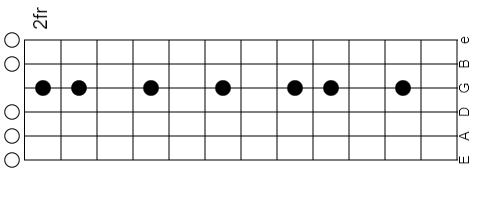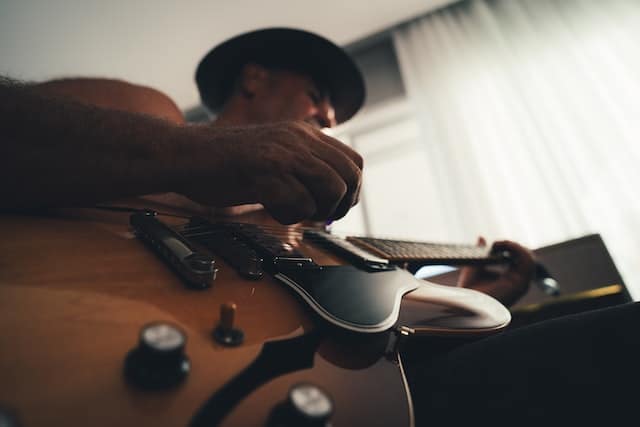Whenever I was at a jamming session and someone said “we are going to play an easy tune in A Dorian”, my hands started shaking. Yes, it’s not only me, naming “guitar modes” is usually intimidating for guitar players.
Yet, they have a wrongly-given bad reputation; they are easy to learn and can be the perfect map for your fretboard. Moreover, they are also a shortcut that can be a giant leap in your career as a musician.
The best five tips to learn guitar modes faster are:
- Play each mode on one string at a time
- Use a 3-note-per-string approach to learn each mode
- Memorize and emphasize the half-steps of each mode to capture its mood
- Train the ear to distinguish each mode by playing them on the same root note
- Memorize the intervals that make each mode
I have been in your shoes before and want to help you out of that initial panic when you come across guitar modes. Furthermore, I want to be an aid in turning these alien terms into a common language every time you pick up your guitar.
Join me on this journey to the very heart of guitar modes and learn how to use one of the most powerful tools for guitar players around the world.
Are you ready? Well, buckle up because here we go!
What Are Modes in Music Theory?
Let’s begin by saying that a mode can be considered a scale within a scale. Yes, the scales offer modes in which the same notes from the parent scale are rearranged.
Also, from a songwriter’s point of view, a mode is the theoretical framework for the melody to be constructed. Moreover, it will dictate what bricks we’ll use to build our song around its melody.
As we choose a mode, we’re choosing a way to organize the notes within a scale according to the intervals formed with the tonic. This is not a detail since it will give the song a certain feel or mood that can then dictate the chords, the lyrics, and the tempo, for example.
I know you might be scratching the top of your head with your pick and going “it sounds a lot like mumbo jumbo”. Let’s simplify it a little further so it becomes easier.
For that, let’s use an example:
You know what the C major scale looks like, right?
C – D – E – F – G – A – B
This group of notes is called the C Major Scale. The same notes in the same order also make the first mode: the natural major scale or Ionian Mode.
The Ionian mode, if we replace notes with distances or intervals, will give us a formula that looks like this:
W – W – H – W – W – W – H
The W stands for a whole tone (2 frets in guitar). The H stands for half-a-tone (1 fret in guitar).
To create each of the remaining 7 Modes, we just need to use the same formula but start from a different degree.
Let’s pour this inside the same example so you can see it clearer:
| Notes of the Parent Scale | C | D | E | F | G | A | B |
| Degrees | I | II | III | IV | V | VI | VII |
| Intervals | W | W | H | W | W | W | H |
So, if we want to move to the second mode, the Dorian Mode, we just need to start from the second degree and rearrange the notes of the parent scale respecting the same intervals.
| Notes of the Parent Scale | D | E | F | G | A | B | C |
| Degrees | II | III | IV | V | VI | VII | I |
| Intervals | W | H | W | W | W | H | W |
But why do we replace notes with intervals?
Well, because that is the beauty of modes; you can just use the distances on your fretboard to construct your scale in each mode.
This is because, when we talk about distances or intervals, we are talking about relationships between notes which will dictate chords and give us an overall mood.
So, we can think of modes as a comprehensive approach to playing, or simply as a compass to move on the fretboard and find the notes we want to play over a given chord or chord progression.
In other words, modes aren’t only a great tool for songwriting; they are a great aid when you’re trying to improvise or solo over a music piece. Yes, the relationship between notes and chords (which we’ll see later on) is paramount to give your audience the chills and get that standing ovation.
Scales vs. Modes
Speaking of solos and jams, many times, the words “mode” and “scale” are used interchangeably. Yet, this is not accurate because, although every mode is a scale, not every scale is a mode.
Moreover, we can say that a mode is a scale within the scale or one of the many flavors that a scale might have. That being said, when you encounter something like a “blues scale”, you’re not talking about a mode.
This is, basically, what you have to know about what modes are from a theoretical perspective.
Are you ready to move on?
Let’s go over each of the modes and learn what we can use them for.
How Many Modes Are There?
Modes in the major scale are 7; one for every degree of the scale.
- Ionian
- Dorian
- Phrygian
- Lydian
- Mixolydian
- Aeolian
- Locrian
These are the modes of the major scale. Each of these modes can be used in a plethora of situations.
Moreover, some of them have similarities with scales that you might know and have been playing for years.
For example, the Aeolian Mode is also called the natural minor scale. Also, the Ionian Mode is known as the natural major scale.
See? Modes have been part of your playing for ages!
Wait, but why do they have those crazy scary names? Well, the reason is that modes originated in Ancient Greece; hence, they have Ancient Greek names from geographical areas of that time.
What are the most common modes?
So, now you know what modes are and how many modes we have. Next, we are going to go through the most common modes; the ones you’ll be using the most.
The Ionian Mode
The first one on the list is the Ionian mode, also known by most people as the major scale. This is, very likely a shape you’re very familiar with.
Also, music-wise, you can hear this mode all over some of the biggest hits in history. Since it is a happy-sounding mode (more on this later), you can find it in megahits like:
- “Free Fallin’” – Tom Petty
- “Crazy Train” – Ozzy Osborne
- “Crazy” – Aerosmith
- “Let it Be” – The Beatles
- “Cliffs of Dover” – Eric Johnson
But what does the Ionian mode look like on a guitar’s neck?
We chose the tonality of G because you can use it in two octaves and have double the fun.
Let’s see what it looks like on a diagram:

| Intervals | W | W | H | W | W | W | H |
The Dorian Mode
The Dorian Mode is the second in the major scale. This means that the notes of the major parent scale are rearranged starting from the second degree.
This rearrangement gives us a relationship between the notes that sounds minor. As a result, the feeling we get from the Dorian Mode is that of sadness or darkness.
You can hear it on megahits like:
- “Wicked Game” – Chris Isaak
- “Purple Haze” – Jimi Hendrix
- “Heart-Shaped Box” – Nirvana
- “Back in Black” – AC-DC
- “Another Brick in the Wall” – Pink Floyd
Let’s see what it looks like on a diagram:

| Intervals | W | H | W | W | W | H | W |
The G Dorian scale is the 2nd mode of the F Major scale.
The Mixolydian Mode
The Mixolydian mode is the fifth mode of the major scale. The rearrangement of the notes gives it a feel that’s compatible with dominant 7th chords and also major chords and happy chord progressions.
Let’s see some examples of songs that have made it big using this mode:
- “Sweet Home Alabama” – Lynyrd Skynyrd
- “Satisfaction” – The Rolling Stones
- “Teardrop” – Massive Attack
- “Summer Song” – Joe Satriani
- “Thunderstruck” – AC-DC
Let’s pour this shape into a diagram so you can see what the G Mixolydian looks like on a guitar neck:

| Intervals | W | W | H | W | W | H | W |
The G Mixolydian scale is the 5th mode of the C major scale.
The Aeolian Mode
Also known as the natural minor scale, this mode starts from the 6th degree of the major parent scale. The notes are rearranged and the flavor of the Aeolian mode is that of the quintessential sad bluesy guitar.
What kinds of songs can you play using this mode? Well, best-selling artists created megahits like these:
- “Smells like a Teen Spirit” – Nirvana
- “Sweet Chile o’ Mine” – Guns n’ Roses
- “Stairway to Heaven” – Led Zeppelin
- “Gimme Shelter” – The Rolling Stones
- “Over the Hills and Far Away” – Gary Moore
Let’s see how this very popular mode looks on the guitar neck in this diagram:

| Intervals | W | H | W | W | H | W | W |
The Aeolian Mode is the sixth mode of the Bb Major Scale.
Why are modes useful for your playing?
I hope you’re enjoying this lesson so far. In case you’re wondering what benefit this knowledge will grant to your playing, we’re about to dive into that topic.
The first and most important benefit of understanding modes is that they can work as a compass. Yes, if you know what mode goes well with a specific chord progression, you can use it to create something that works without relying solely on your ear.
Let’s see the quality of the modes.
- Ionian – Major
- Dorian – Minor
- Phrygian – Minor
- Lydian – Major
- Mixolydian – Major
- Aeolian – Minor
- Locrian – Diminished
The Major Modes
The three major modes are Ionian, Lydian, and Mixolydian (which also works great on dominant chords). As a rule of thumb, they can be a great choice to play over choruses, major chords, and happy arrangements.
You can take this information as a shortcut when you’re songwriting and use any of these three modes to play over major and dominant 7th chords. As you get familiar with them, you’ll realize that each has a distinctive flavor.
The Minor Modes
The minor modes are Dorian, Aeolian, and Phrygian. Again, this is a rule of thumb, but these modes can work wonders to convey sadness or darkness. Moreover, if you want to give a happy chorus an extra layer of texture, you can use a minor mode to work a melody over it.
An interesting thing about these modes is that they are very close to the structure of a minor pentatonic. Therefore, you can use them to create some more complex melodies using a 7-note scale where you would normally use a 5-note one.
The “Odd One Out” Mode
Locrian is the 7th mode of the parent scale which means it’s got a diminished flavor. This makes it very hard to use in the context of a chord progression.
As a rule of thumb, you can use it over diminished and half-diminished chords (m7b5). Also, you can master this mode to give an odd flavor to any composition, taking it to the next level.
Finally, if you are in a jam session that requires some one-of-a-kind playing, you’ll get everybody’s attention by playing this mode.
5 Tips to Learn Scale Modes Faster
Now that you know the benefits of the modes, let’s go through the tips to learn them faster. I’ve been there too, and I know that they look complex, endless, and scary.
Fear not because you’re in the correct place at the correct time. I’m about to pass on to you over 25 years of guitar playing in the shape of effective, tried-and-true tips.
1. Try the mode on one string
The first tip to make modes part of your playing is to try to build the knowledge one string at a time. Yes, this means using your guitar neck horizontally instead of vertically.
For this exercise, all you need to know is the notes that are part of that mode, and then find them on a single string of your choice. I usually go for the 3rd string (G) just because I think it’s the most expressive of them all.
So, let’s say we go back to our G Dorian mode and try to locate every note on our fretboard. It will look something like this:

Once you’ve mastered one string, it is time to move to the next. Try to make small licks remembering where your fingers go.
When you’re done with the third string, try to add the fourth and so on. This way, you’ll build your mode scales on solid foundations.
2. Using the 3-note-Per-String Approach
Every mode of every scale can be played in a three-note-per-string approach. Furthermore, just like you did in tip number one, you can also use the interval and notes to construct the scale going vertically.
So, to do this, you need to start from the low E string and find the intervals for each of the strings until you reach the high E.
This structure you have just formed can be moved around the fretboard to play the same mode on a different key or root.
How you might ask?
Well, very simple; just move the same structure minding the root note and you’ll be playing the same mode in a different spot of the fretboard.
You can get started with the diagrams above and expand from there.
3. The Magic is in the Half-Steps
One of the most characteristic things of any mode is where the half-steps are. Yes, they are the notes that will make that mode sound more like, well, like itself.
So, for example, let’s take the Aeolian Mode. It is, as you know already, one of the minor modes.
The characteristic of the Aeolian Mode, what makes it sound the way it does is its flat 6th and the flat 3rd. So, if you can find these notes in your playing and emphasize those using larger figures, you can start grasping that “Aeolian sound”.
Thus, try to find the half-notes in the rest of the modes and emphasize them. This is great to memorize them and to start learning how to play those specific notes over the correct chords and take your playing to the next level.
4. Train your Ear
One of the biggest mistakes is trying to learn all the modes of the same parent scale as a sequence going from Ionian to Dorian to Phrygian to Lydian and so on.
Why is this a big mistake?
Well, because you’re rearranging the notes of the major scale and everything will sound kind of major all the time. Yes, it is very hard to distinguish modes or know the difference when you play them one after the other.
So, how do we train the ear? Well, instead of playing the seven modes of the C major scale, for example, try to practice every mode in the same root.
Sounds familiar?
Yes, it is exactly what we did above playing every mode in the key of G. So, for example, the G Dorian is the 2nd degree of the F major scale. In the same way, the G Mixolydian is the 5th degree of the C major scale.
Once your ear is trained to recognize a mode, it will help you use it where it should go.
5. Learn the Intervals (and Think in Intervals)
When we talked about intervals above, we were trying to push a musical concept forward that is paramount for every guitar player’s career: music is made of intervals. Yes, it is the distance between the notes that creates the nuances and flavors in music.
For example, if you have ever played covers backing up a singer (or if you are one), you know that songs can be moved from one key to another. As long as you respect the distance or intervals, it will sound like the original… in a different pitch.
We do this to accommodate singers’ voices. We can play the guitar everywhere on the neck but they can’t sing out of their register.
What does this have to do with modes? Well, the answer is that if you memorize the intervals (remember the W – H thing?) of every mode, you can construct your own pathways to play every mode.
Yes, this will unlock every guitar box and turn the guitar neck into a musical highway with limitless, endless possibilities.
How to use modes to improvise?
All of the above sounds very nice, but what happens when you take the stage again in the next jam session and the same guy goes “let’s play something easy in A Dorian”?
Well, there are some key takeaways from that statement:
- Dorian is a minor mode, so you’ll be playing something sad, dark, or both.
- A Dorian is the second mode of the G major scale. Hence, you can go full-throttle back and forth from these two scales giving the jam some dynamics.
- As long as you remember the intervals in the Dorian mode (W – H – W – W – W – H – W), you can use the guitar neck horizontally and vertically.
But that’s not all, because even if that guy doesn’t call out the Dorian thing, you can still make out which the best mode to use over the ongoing chord progression is.
How so? You might ask.
Well, using the quality of the chords, you know what the best mode to play over them is.
Conclusion
Guitar modes are not restricted to what we’ve just seen; guitar modes are a vast topic that can take years to master. Yet, this article is the first step in that direction.
So, take all the information here, let it sink in, and try to incorporate modes into your own playing style.
As long as you practice playing them string by string, memorize intervals, emphasize half-notes, and learn to differentiate them properly, you’ll be on the right track.
Get ready to be the guitar player you’ve always dreamt of mastering modes on your guitar.
Happy playing!

Hello there, my name is Ramiro and I’ve been playing guitar for almost 20 years. I’m obsessed with everything gear-related and I thought it might be worth sharing it. From guitars, pedals, amps, and synths to studio gear and production tips, I hope you find what I post here useful, and I’ll try my best to keep it entertaining also.





